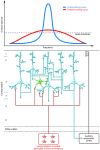Schizophrenia from a neural circuitry perspective: advancing toward rational pharmacological therapies
- PMID: 19339762
- PMCID: PMC2662560
- DOI: 10.1172/JCI37335
Schizophrenia from a neural circuitry perspective: advancing toward rational pharmacological therapies
Abstract
Schizophrenia is a severe disorder that disrupts the function of multiple brain systems, resulting in impaired social and occupational functioning. The etiology and pathogenesis of schizophrenia appear to involve the interplay of a potentially large number of genetic liabilities and adverse environmental events that disrupt brain developmental pathways. In this Review, we discuss a strategy for determining how particular common and core clinical features of the illness are associated with pathophysiology in certain circuits of the cerebral cortex. The identification of molecular alterations in these circuits is providing critical insights for the rational development of new therapeutic interventions.
Figures





References
-
- Parks, J., Svendsen, D., Singer, P., and Foti, M. 2006. Morbidity and mortality in people with serious mental illness. National Association of State Mental Health Program Directors (NASMHPD) Medical Directors Council. Alexandria, Virginia, USA. http://www.bu.edu/cpr/resources/wellness-summit/documents/morbidity-and-....
-
- Green M.F. What are the functional consequences of neurocognitive deficits in schizophrenia? Am. J. Psychiatry. 1996;153:321–330. - PubMed

